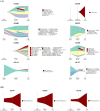Pairwise analysis of plasma cell-free DNA before and after palliative second-line paclitaxel plus ramucirumab treatment in patients with metastatic gastric cancer
- PMID: 40148708
- PMCID: PMC12174237
- DOI: 10.1007/s10120-025-01604-y
Pairwise analysis of plasma cell-free DNA before and after palliative second-line paclitaxel plus ramucirumab treatment in patients with metastatic gastric cancer
Abstract
Background: This study compared plasma cell-free DNA (cfDNA) and tumor tissue DNA (ttDNA) to explore the clinical applicability of cfDNA in patients with metastatic gastric cancer (mGC) receiving palliative second-line paclitaxel + ramucirumab treatment.
Methods: Targeted sequencing of 106 genes was conducted using germline DNA and cfDNA at baseline (baseline-cfDNA) and progressive disease (PD-cfDNA). The results were compared with those of ttDNA-based cancer panel data.
Results: Of 76 consecutive patients, 46 (27 males; median age 57.5 [range, 32-73] years) who had all three samples were included. Combined analysis of ttDNA and baseline-cfDNA revealed that TP53 (58.7%) was the most frequently mutated gene, followed by CDH1 (26.1%), KRAS (21.7%), and APC (13.0%). For these genes, the sensitivity and positive predictive value of baseline-cfDNA over ttDNA were 71.8% and 51.9%, respectively. When baseline-cfDNA and PD-cfDNA results were combined, 34 patients (73.9%) were found to have additional mutations compared with ttDNA results alone. PD-cfDNA analysis revealed 14 novel pathogenic mutations in ten patients (21.7%). At baseline, patients with a high circulating tumor DNA fraction concentration showed a significantly shorter progression-free survival (PFS) (P = 0.016) in univariable and multivariable analyses. High maximal variant allele frequency (VAF) (P = 0.022), high sum of VAF (P = 0.028), and high TP53 VAF (P = 0.022) were associated with worse PFS in univariable analysis.
Conclusions: Although cfDNA alone cannot replace ttDNA entirely, cfDNA analysis revealed additional mutations. Notably, PD-cfDNA analysis revealed novel pathogenic mutations that emerged during treatment. Moreover, the baseline circulating tumor DNA fraction concentration and VAF values were associated with longer PFS.
Keywords: Anti-cancer therapy; Cell-free DNA; Circulating tumor DNA; Clonal evolution; Gastric cancer.
© 2025. The Author(s).
Conflict of interest statement
Declarations. Conflict of interest: Kyung DS, Ko WY, and Kim H-P are employees of IMBdx, Inc. The other authors declare no conflicts of interest.
Figures



References
-
- Sung H, Ferlay J, Siegel RL, Laversanne M, Soerjomataram I, Jemal A, et al. Global Cancer Statistics 2020: GLOBOCAN Estimates of Incidence and Mortality Worldwide for 36 Cancers in 185 Countries. CA Cancer J Clin. 2021;71(3):209–49. - PubMed
-
- McGranahan N, Swanton C. Clonal heterogeneity and tumor evolution: past, present, and the future. Cell. 2017;168(4):613–28. - PubMed
-
- Wilke H, Muro K, Van Cutsem E, Oh SC, Bodoky G, Shimada Y, et al. Ramucirumab plus paclitaxel versus placebo plus paclitaxel in patients with previously treated advanced gastric or gastro-oesophageal junction adenocarcinoma (RAINBOW): a double-blind, randomised phase 3 trial. Lancet Oncol. 2014;15(11):1224–35. - PubMed
MeSH terms
Substances
Grants and funding
LinkOut - more resources
Full Text Sources
Medical
Research Materials
Miscellaneous

